Dosing & Uses
Dosage Forms & Strengths
metered-dose inhaler
- 17mcg/actuation
nebulized solution
- 0.02%
Chronic Obstructive Pulmonary Disease
Maintenance treatment of bronchospasm, including chronic bronchitis and emphysema
Inhaler: 2 actuations (34 mcg) q6hr, then additional actuations PRN; not to exceed 12 actuations/day (408 mcg/day)
Nebulizer: 2.5 mL (500 mcg) q6-8hr
Acute Asthma Exacerbation (Off-label)
Inhaler: 8 actuations (136 mcg) q20min PRN for 3 hr
Nebulizer: 500 mcg q20min for 3 doses, then PRN
Administration
Prime before initial use by releasing 2 test sprays into air; repeat priming if unused for ≥3 days
Dosing Considerations
In treatment of acute asthma exacerbation with inhaler, short-acting beta agonist (SABA) must be coadministered
Dosage Forms & Strengths
metered-dose inhaler
- 17 mcg/actuation
nebulized solution
- 0.02%
Acute Asthma Exacerbation (Off-label)
NIH asthma guidelines
- <5 years (inhaler): 2 inhalations q20min for 1 hr if necessary
- 5-12 years (inhaler): 4-8 actuations q20 min PRN for up to 3 hr
- ≥12 years (inhaler): 8 actuations q20 min PRN for up to 3 hr
- <5 years (nebulizer): 0.25 mg (250 mcg) q20min for 1 hr if necessary
- 5-12 years (nebulizer): 250-500 mcg q20 min for 3 doses, then PRN
- ≥12 years (nebulizer): 500 mcg q20 min for 3 doses, then PRN
Interactions
Interaction Checker
No Results

Contraindicated
Serious - Use Alternative
Significant - Monitor Closely
Minor

Contraindicated (0)
Serious - Use Alternative (6)
- glucagon
glucagon increases toxicity of ipratropium by Other (see comment). Avoid or Use Alternate Drug. Comment: Coadministration of anticholinergic drugs and glucagon increase the risk of gastrointestinal adverse reactions due to additive effects on inhibition of gastrointestinal motility. .
- glucagon intranasal
glucagon intranasal increases toxicity of ipratropium by Other (see comment). Avoid or Use Alternate Drug. Comment: Coadministration of anticholinergic drugs and glucagon increase the risk of gastrointestinal adverse reactions due to additive effects on inhibition of gastrointestinal motility. .
- macimorelin
ipratropium, macimorelin. unspecified interaction mechanism. Avoid or Use Alternate Drug. Drugs that may blunt the growth hormone (GH) response to macrimorelin may impact the accuracy of the diagnostic test. Allow sufficient washout time of drugs affecting GH release before administering macimorelin.
- pramlintide
pramlintide, ipratropium. Either increases effects of the other by pharmacodynamic synergism. Contraindicated. Synergistic inhibition of GI motility.
- revefenacin
revefenacin and ipratropium both decrease cholinergic effects/transmission. Avoid or Use Alternate Drug. Coadministration may cause additive anticholinergic effects.
- umeclidinium bromide/vilanterol inhaled
ipratropium, umeclidinium bromide/vilanterol inhaled. Either increases toxicity of the other by pharmacodynamic synergism. Avoid or Use Alternate Drug. Concomitant use with other anticholinergic-containing drugs may lead to additive anticholinergic adverse effects.
Monitor Closely (93)
- aclidinium
ipratropium and aclidinium both decrease cholinergic effects/transmission. Use Caution/Monitor.
- amantadine
ipratropium, amantadine. Mechanism: pharmacodynamic synergism. Use Caution/Monitor. Potential for increased anticholinergic adverse effects.
- amitriptyline
ipratropium and amitriptyline both decrease cholinergic effects/transmission. Use Caution/Monitor. Due to the poor systemic absorption of ipratropium, interaction unlikely at regularly recommended dosages.
- amoxapine
ipratropium and amoxapine both decrease cholinergic effects/transmission. Use Caution/Monitor. Due to the poor systemic absorption of ipratropium, interaction unlikely at regularly recommended dosages.
- anticholinergic/sedative combos
anticholinergic/sedative combos and ipratropium both decrease cholinergic effects/transmission. Use Caution/Monitor.
- aripiprazole
ipratropium decreases levels of aripiprazole by inhibition of GI absorption. Applies only to oral form of both agents. Use Caution/Monitor.
ipratropium decreases levels of aripiprazole by pharmacodynamic antagonism. Use Caution/Monitor.
aripiprazole increases effects of ipratropium by pharmacodynamic synergism. Use Caution/Monitor. Additive anticholinergic effects, possible hypoglycemia. - atracurium
atracurium and ipratropium both decrease cholinergic effects/transmission. Use Caution/Monitor.
- atropine
atropine and ipratropium both decrease cholinergic effects/transmission. Use Caution/Monitor. Due to the poor systemic absorption of ipratropium, interaction unlikely at regularly recommended dosages.
- atropine IV/IM
atropine IV/IM and ipratropium both decrease cholinergic effects/transmission. Use Caution/Monitor.
- belladonna alkaloids
belladonna alkaloids and ipratropium both decrease cholinergic effects/transmission. Use Caution/Monitor. Due to the poor systemic absorption of ipratropium, interaction unlikely at regularly recommended dosages.
- belladonna and opium
ipratropium and belladonna and opium both decrease cholinergic effects/transmission. Use Caution/Monitor.
- benperidol
ipratropium decreases levels of benperidol by inhibition of GI absorption. Applies only to oral form of both agents. Use Caution/Monitor.
ipratropium decreases levels of benperidol by pharmacodynamic antagonism. Use Caution/Monitor.
benperidol increases effects of ipratropium by pharmacodynamic synergism. Use Caution/Monitor. Additive anticholinergic effects, possible hypoglycemia. - benztropine
benztropine and ipratropium both decrease cholinergic effects/transmission. Use Caution/Monitor. Additive anticholinergic adverse effects may be seen with concurrent use.
- bethanechol
bethanechol increases and ipratropium decreases cholinergic effects/transmission. Effect of interaction is not clear, use caution. Use Caution/Monitor.
- carbachol
carbachol increases and ipratropium decreases cholinergic effects/transmission. Effect of interaction is not clear, use caution. Use Caution/Monitor.
- cevimeline
cevimeline increases and ipratropium decreases cholinergic effects/transmission. Effect of interaction is not clear, use caution. Use Caution/Monitor.
- chlorpromazine
ipratropium decreases levels of chlorpromazine by inhibition of GI absorption. Applies only to oral form of both agents. Use Caution/Monitor.
ipratropium decreases levels of chlorpromazine by pharmacodynamic antagonism. Use Caution/Monitor.
chlorpromazine increases effects of ipratropium by pharmacodynamic synergism. Use Caution/Monitor. Additive anticholinergic effects, possible hypoglycemia. - cisatracurium
cisatracurium and ipratropium both decrease cholinergic effects/transmission. Use Caution/Monitor.
- clomipramine
ipratropium and clomipramine both decrease cholinergic effects/transmission. Use Caution/Monitor. Due to the poor systemic absorption of ipratropium, interaction unlikely at regularly recommended dosages.
- clozapine
ipratropium decreases levels of clozapine by inhibition of GI absorption. Applies only to oral form of both agents. Use Caution/Monitor.
ipratropium decreases levels of clozapine by pharmacodynamic antagonism. Use Caution/Monitor.
clozapine increases effects of ipratropium by pharmacodynamic synergism. Use Caution/Monitor. Additive anticholinergic effects, possible hypoglycemia. - cyclizine
cyclizine and ipratropium both decrease cholinergic effects/transmission. Use Caution/Monitor. Due to the poor systemic absorption of ipratropium, interaction unlikely at regularly recommended dosages.
- cyclobenzaprine
cyclobenzaprine and ipratropium both decrease cholinergic effects/transmission. Use Caution/Monitor.
- darifenacin
darifenacin and ipratropium both decrease cholinergic effects/transmission. Use Caution/Monitor. Due to the poor systemic absorption of ipratropium, interaction unlikely at regularly recommended dosages.
- desipramine
ipratropium and desipramine both decrease cholinergic effects/transmission. Use Caution/Monitor. Due to the poor systemic absorption of ipratropium, interaction unlikely at regularly recommended dosages.
- dicyclomine
dicyclomine and ipratropium both decrease cholinergic effects/transmission. Use Caution/Monitor. Due to the poor systemic absorption of ipratropium, interaction unlikely at regularly recommended dosages.
- diphenhydramine
diphenhydramine and ipratropium both decrease cholinergic effects/transmission. Use Caution/Monitor. Due to the poor systemic absorption of ipratropium, interaction unlikely at regularly recommended dosages.
- donepezil
donepezil increases and ipratropium decreases cholinergic effects/transmission. Effect of interaction is not clear, use caution. Use Caution/Monitor.
- donepezil transdermal
donepezil transdermal, ipratropium. Either decreases effects of the other by pharmacodynamic antagonism. Use Caution/Monitor.
- dosulepin
ipratropium and dosulepin both decrease cholinergic effects/transmission. Use Caution/Monitor.
- doxepin
ipratropium and doxepin both decrease cholinergic effects/transmission. Use Caution/Monitor. Due to the poor systemic absorption of ipratropium, interaction unlikely at regularly recommended dosages.
- droperidol
ipratropium decreases levels of droperidol by inhibition of GI absorption. Applies only to oral form of both agents. Use Caution/Monitor.
ipratropium decreases levels of droperidol by pharmacodynamic antagonism. Use Caution/Monitor.
droperidol increases effects of ipratropium by pharmacodynamic synergism. Use Caution/Monitor. Additive anticholinergic effects, possible hypoglycemia. - echothiophate iodide
echothiophate iodide increases and ipratropium decreases cholinergic effects/transmission. Effect of interaction is not clear, use caution. Use Caution/Monitor.
- fesoterodine
fesoterodine and ipratropium both decrease cholinergic effects/transmission. Use Caution/Monitor. Due to the poor systemic absorption of ipratropium, interaction unlikely at regularly recommended dosages.
- flavoxate
flavoxate and ipratropium both decrease cholinergic effects/transmission. Use Caution/Monitor. Due to the poor systemic absorption of ipratropium, interaction unlikely at regularly recommended dosages.
- fluphenazine
ipratropium decreases levels of fluphenazine by inhibition of GI absorption. Applies only to oral form of both agents. Use Caution/Monitor.
ipratropium decreases levels of fluphenazine by pharmacodynamic antagonism. Use Caution/Monitor.
fluphenazine increases effects of ipratropium by pharmacodynamic synergism. Use Caution/Monitor. Additive anticholinergic effects, possible hypoglycemia. - galantamine
galantamine increases and ipratropium decreases cholinergic effects/transmission. Effect of interaction is not clear, use caution. Use Caution/Monitor.
- glycopyrrolate
glycopyrrolate and ipratropium both decrease cholinergic effects/transmission. Use Caution/Monitor.
- glycopyrrolate inhaled
glycopyrrolate inhaled and ipratropium both decrease cholinergic effects/transmission. Use Caution/Monitor.
- glycopyrronium tosylate topical
glycopyrronium tosylate topical, ipratropium. Either increases effects of the other by pharmacodynamic synergism. Use Caution/Monitor. Coadministration of glycopyrronium tosylate topical with other anticholinergic medications may result in additive anticholinergic adverse effects.
- haloperidol
ipratropium decreases levels of haloperidol by inhibition of GI absorption. Applies only to oral form of both agents. Use Caution/Monitor.
ipratropium decreases levels of haloperidol by pharmacodynamic antagonism. Use Caution/Monitor.
haloperidol increases effects of ipratropium by pharmacodynamic synergism. Use Caution/Monitor. Additive anticholinergic effects, possible hypoglycemia. - henbane
henbane and ipratropium both decrease cholinergic effects/transmission. Use Caution/Monitor.
- homatropine
homatropine and ipratropium both decrease cholinergic effects/transmission. Use Caution/Monitor. Due to the poor systemic absorption of ipratropium, interaction unlikely at regularly recommended dosages.
- huperzine A
huperzine A increases and ipratropium decreases cholinergic effects/transmission. Effect of interaction is not clear, use caution. Use Caution/Monitor.
- hyoscyamine
hyoscyamine and ipratropium both decrease cholinergic effects/transmission. Use Caution/Monitor. Due to the poor systemic absorption of ipratropium, interaction unlikely at regularly recommended dosages.
- hyoscyamine spray
hyoscyamine spray and ipratropium both decrease cholinergic effects/transmission. Use Caution/Monitor.
- iloperidone
ipratropium decreases levels of iloperidone by inhibition of GI absorption. Applies only to oral form of both agents. Use Caution/Monitor.
ipratropium decreases levels of iloperidone by pharmacodynamic antagonism. Use Caution/Monitor.
iloperidone increases effects of ipratropium by pharmacodynamic synergism. Use Caution/Monitor. Additive anticholinergic effects, possible hypoglycemia. - imipramine
ipratropium and imipramine both decrease cholinergic effects/transmission. Use Caution/Monitor. Due to the poor systemic absorption of ipratropium, interaction unlikely at regularly recommended dosages.
- lofepramine
ipratropium and lofepramine both decrease cholinergic effects/transmission. Use Caution/Monitor.
- loxapine
ipratropium decreases levels of loxapine by inhibition of GI absorption. Applies only to oral form of both agents. Use Caution/Monitor.
ipratropium decreases levels of loxapine by pharmacodynamic antagonism. Use Caution/Monitor.
loxapine increases effects of ipratropium by pharmacodynamic synergism. Use Caution/Monitor. Additive anticholinergic effects, possible hypoglycemia. - loxapine inhaled
loxapine inhaled increases effects of ipratropium by pharmacodynamic synergism. Use Caution/Monitor. Additive anticholinergic effects, possible hypoglycemia.
ipratropium decreases levels of loxapine inhaled by pharmacodynamic antagonism. Use Caution/Monitor. - maprotiline
ipratropium and maprotiline both decrease cholinergic effects/transmission. Use Caution/Monitor. Due to the poor systemic absorption of ipratropium, interaction unlikely at regularly recommended dosages.
- meclizine
ipratropium and meclizine both decrease cholinergic effects/transmission. Use Caution/Monitor. Due to the poor systemic absorption of ipratropium, interaction unlikely at regularly recommended dosages.
- methscopolamine
ipratropium and methscopolamine both decrease cholinergic effects/transmission. Use Caution/Monitor. Due to the poor systemic absorption of ipratropium, interaction unlikely at regularly recommended dosages.
- neostigmine
neostigmine increases and ipratropium decreases cholinergic effects/transmission. Effect of interaction is not clear, use caution. Use Caution/Monitor.
- nortriptyline
ipratropium and nortriptyline both decrease cholinergic effects/transmission. Use Caution/Monitor. Due to the poor systemic absorption of ipratropium, interaction unlikely at regularly recommended dosages.
- olanzapine
ipratropium decreases levels of olanzapine by inhibition of GI absorption. Applies only to oral form of both agents. Use Caution/Monitor.
ipratropium decreases levels of olanzapine by pharmacodynamic antagonism. Use Caution/Monitor.
olanzapine increases effects of ipratropium by pharmacodynamic synergism. Use Caution/Monitor. Additive anticholinergic effects, possible hypoglycemia. - olanzapine/samidorphan
ipratropium, olanzapine/samidorphan. Either increases effects of the other by pharmacodynamic synergism. Use Caution/Monitor. Coadministration of olanzapine and other drugs with anticholinergic (antimuiscarinic) activity can increase risk for severe gastrointestinal adverse reactions related to hypomotility. .
- orphenadrine
ipratropium and orphenadrine both decrease cholinergic effects/transmission. Use Caution/Monitor.
- oxybutynin
ipratropium and oxybutynin both decrease cholinergic effects/transmission. Use Caution/Monitor. Due to the poor systemic absorption of ipratropium, interaction unlikely at regularly recommended dosages.
- oxybutynin topical
ipratropium and oxybutynin topical both decrease cholinergic effects/transmission. Use Caution/Monitor. Due to the poor systemic absorption of ipratropium, interaction unlikely at regularly recommended dosages.
- oxybutynin transdermal
ipratropium and oxybutynin transdermal both decrease cholinergic effects/transmission. Use Caution/Monitor. Due to the poor systemic absorption of ipratropium, interaction unlikely at regularly recommended dosages.
- paliperidone
ipratropium decreases levels of paliperidone by inhibition of GI absorption. Applies only to oral form of both agents. Use Caution/Monitor.
ipratropium decreases levels of paliperidone by pharmacodynamic antagonism. Use Caution/Monitor.
paliperidone increases effects of ipratropium by pharmacodynamic synergism. Use Caution/Monitor. Additive anticholinergic effects, possible hypoglycemia. - pancuronium
ipratropium and pancuronium both decrease cholinergic effects/transmission. Use Caution/Monitor.
- perphenazine
ipratropium decreases levels of perphenazine by inhibition of GI absorption. Applies only to oral form of both agents. Use Caution/Monitor.
ipratropium decreases levels of perphenazine by pharmacodynamic antagonism. Use Caution/Monitor.
perphenazine increases effects of ipratropium by pharmacodynamic synergism. Use Caution/Monitor. Additive anticholinergic effects, possible hypoglycemia. - physostigmine
physostigmine increases and ipratropium decreases cholinergic effects/transmission. Effect of interaction is not clear, use caution. Use Caution/Monitor.
- pilocarpine
pilocarpine increases and ipratropium decreases cholinergic effects/transmission. Effect of interaction is not clear, use caution. Use Caution/Monitor.
- pimozide
ipratropium decreases levels of pimozide by inhibition of GI absorption. Applies only to oral form of both agents. Use Caution/Monitor.
ipratropium decreases levels of pimozide by pharmacodynamic antagonism. Use Caution/Monitor.
pimozide increases effects of ipratropium by pharmacodynamic synergism. Use Caution/Monitor. Additive anticholinergic effects, possible hypoglycemia. - pralidoxime
ipratropium and pralidoxime both decrease cholinergic effects/transmission. Use Caution/Monitor. Due to the poor systemic absorption of ipratropium, interaction unlikely at regularly recommended dosages.
- prochlorperazine
ipratropium decreases levels of prochlorperazine by inhibition of GI absorption. Applies only to oral form of both agents. Use Caution/Monitor.
ipratropium decreases levels of prochlorperazine by pharmacodynamic antagonism. Use Caution/Monitor.
prochlorperazine increases effects of ipratropium by pharmacodynamic synergism. Use Caution/Monitor. Additive anticholinergic effects, possible hypoglycemia. - promethazine
ipratropium decreases levels of promethazine by inhibition of GI absorption. Applies only to oral form of both agents. Use Caution/Monitor.
ipratropium decreases levels of promethazine by pharmacodynamic antagonism. Use Caution/Monitor.
promethazine increases effects of ipratropium by pharmacodynamic synergism. Use Caution/Monitor. Additive anticholinergic effects, possible hypoglycemia. - propantheline
ipratropium and propantheline both decrease cholinergic effects/transmission. Use Caution/Monitor. Due to the poor systemic absorption of ipratropium, interaction unlikely at regularly recommended dosages.
- protriptyline
ipratropium and protriptyline both decrease cholinergic effects/transmission. Use Caution/Monitor.
- pyridostigmine
pyridostigmine increases and ipratropium decreases cholinergic effects/transmission. Effect of interaction is not clear, use caution. Use Caution/Monitor.
- quetiapine
ipratropium decreases levels of quetiapine by inhibition of GI absorption. Applies only to oral form of both agents. Use Caution/Monitor.
ipratropium decreases levels of quetiapine by pharmacodynamic antagonism. Use Caution/Monitor.
quetiapine increases effects of ipratropium by pharmacodynamic synergism. Use Caution/Monitor. Additive anticholinergic effects, possible hypoglycemia. - rapacuronium
ipratropium and rapacuronium both decrease cholinergic effects/transmission. Use Caution/Monitor.
- risperidone
risperidone increases effects of ipratropium by pharmacodynamic synergism. Use Caution/Monitor. Additive anticholinergic effects, possible hypoglycemia.
- rocuronium
ipratropium and rocuronium both decrease cholinergic effects/transmission. Use Caution/Monitor.
- scopolamine
ipratropium and scopolamine both decrease cholinergic effects/transmission. Use Caution/Monitor. Due to the poor systemic absorption of ipratropium, interaction unlikely at regularly recommended dosages.
- solifenacin
ipratropium and solifenacin both decrease cholinergic effects/transmission. Use Caution/Monitor. Due to the poor systemic absorption of ipratropium, interaction unlikely at regularly recommended dosages.
- succinylcholine
succinylcholine increases and ipratropium decreases cholinergic effects/transmission. Effect of interaction is not clear, use caution. Use Caution/Monitor.
- thioridazine
ipratropium decreases levels of thioridazine by inhibition of GI absorption. Applies only to oral form of both agents. Use Caution/Monitor.
ipratropium decreases levels of thioridazine by pharmacodynamic antagonism. Use Caution/Monitor.
thioridazine increases effects of ipratropium by pharmacodynamic synergism. Use Caution/Monitor. Additive anticholinergic effects, possible hypoglycemia. - thiothixene
ipratropium decreases levels of thiothixene by inhibition of GI absorption. Applies only to oral form of both agents. Use Caution/Monitor.
ipratropium decreases levels of thiothixene by pharmacodynamic antagonism. Use Caution/Monitor.
thiothixene increases effects of ipratropium by pharmacodynamic synergism. Use Caution/Monitor. Additive anticholinergic effects, possible hypoglycemia. - tiotropium
ipratropium and tiotropium both decrease cholinergic effects/transmission. Use Caution/Monitor. Due to the poor systemic absorption of ipratropium, interaction unlikely at regularly recommended dosages.
- tolterodine
ipratropium and tolterodine both decrease cholinergic effects/transmission. Use Caution/Monitor. Due to the poor systemic absorption of ipratropium, interaction unlikely at regularly recommended dosages.
- trazodone
ipratropium and trazodone both decrease cholinergic effects/transmission. Use Caution/Monitor.
- trifluoperazine
ipratropium decreases levels of trifluoperazine by inhibition of GI absorption. Applies only to oral form of both agents. Use Caution/Monitor.
ipratropium decreases levels of trifluoperazine by pharmacodynamic antagonism. Use Caution/Monitor.
trifluoperazine increases effects of ipratropium by pharmacodynamic synergism. Use Caution/Monitor. Additive anticholinergic effects, possible hypoglycemia. - trihexyphenidyl
ipratropium and trihexyphenidyl both decrease cholinergic effects/transmission. Use Caution/Monitor. Potential for additive anticholinergic effects.
- trimipramine
ipratropium and trimipramine both decrease cholinergic effects/transmission. Use Caution/Monitor. Due to the poor systemic absorption of ipratropium, interaction unlikely at regularly recommended dosages.
- trospium chloride
ipratropium and trospium chloride both decrease cholinergic effects/transmission. Use Caution/Monitor. Due to the poor systemic absorption of ipratropium, interaction unlikely at regularly recommended dosages.
- umeclidinium bromide
umeclidinium bromide and ipratropium both decrease cholinergic effects/transmission. Use Caution/Monitor. If possible, avoid coadministration of additional anticholinergic agents
- vecuronium
ipratropium and vecuronium both decrease cholinergic effects/transmission. Use Caution/Monitor. Due to the poor systemic absorption of ipratropium, interaction unlikely at regularly recommended dosages.
- ziprasidone
ipratropium decreases levels of ziprasidone by inhibition of GI absorption. Applies only to oral form of both agents. Use Caution/Monitor.
ipratropium decreases levels of ziprasidone by pharmacodynamic antagonism. Use Caution/Monitor.
ziprasidone increases effects of ipratropium by pharmacodynamic synergism. Use Caution/Monitor. Additive anticholinergic effects, possible hypoglycemia. - zotepine
ipratropium decreases levels of zotepine by inhibition of GI absorption. Applies only to oral form of both agents. Use Caution/Monitor.
ipratropium decreases levels of zotepine by pharmacodynamic antagonism. Use Caution/Monitor.
Minor (4)
- dimenhydrinate
dimenhydrinate increases toxicity of ipratropium by pharmacodynamic synergism. Minor/Significance Unknown. Additive anticholinergic effects.
- donepezil
donepezil decreases effects of ipratropium by pharmacodynamic antagonism. Minor/Significance Unknown.
- galantamine
galantamine decreases effects of ipratropium by pharmacodynamic antagonism. Minor/Significance Unknown.
- levodopa
ipratropium, levodopa. Other (see comment). Minor/Significance Unknown. Comment: Anticholinergic agents may enhance the therapeutic effects of levodopa; however, anticholinergic agents can exacerbate tardive dyskinesia. In high dosage, anticholinergics may decrease the effects of levodopa by delaying its GI absorption. .
Adverse Effects
>10%
Bronchitis (10-23%)
Chronic obstructive pulmonary disease (COPD) exacerbation (8-23%)
Sinusitis (1-14%)
1-10%
Dyspnea (4-10%)
Urinary tract infection (UTI) (2-10%)
Headache (5-9%)
Flulike symptoms (2-8%)
Back pain (2-7%)
Cough (5.9%)
Dyspepsia (1-5%)
Dry mouth (2-4%)
Dizziness (1-3%)
Nausea (2.8%)
Frequency Not Defined
Cardiovascular: Hypotension, palpitations, tachycardia
General: Dry throat, throat irritation
Gastrointestinal (GI): Constipation, stomatitis, mouth edema
Sensory: Narrow-angle glaucoma, glaucoma, halo vision, conjunctival hyperemia, corneal edema, mydriasis, acute eye pain, blurry vision
Respiratory: Bronchospasm, including paradoxical bronchospasm
Renal: Urinary retention
Warnings
Contraindications
Documented hypersensitivity to ipratropium, atropine, or derivatives
Cautions
Use for maintenance treatment only; should not be used as rescue therapy
Inhaled bronchodilating agents may cause life-threatening paradoxical bronchospasm that should be differentiated from inadequate response
Hypersensitivity reactions (skin rash, pruritus, angioedema, urticaria/giant urticaria, laryngospasm) reported; discontinue immediately, and use alternative treatment
May cause urinary retention; use with caution in patients with benign prostatic hyperplasia (BPH) or bladder-neck obstruction
Use caution in patients with myasthenia gravis
May worsen narrow-angle glaucoma
Inhalation/nebulizer not indicated for initial treatment of acute episodes of bronchospasm; rescue therapy required
Pregnancy & Lactation
Pregnancy
Ipratropium is negligibly absorbed systemically following oral inhalation; therefore, maternal use is not expected to result in fetal exposure to the drug
Experience with ipratropium bromide use in pregnant women over several decades, based on published literature, including cohort studies, case control studies and case series, have not identified a drug associated risk of major birth defects, miscarriage or adverse maternal or fetal outcomes
Animal data
- Based on animal reproduction animal studies, no evidence of structural alternations was observed when ipratropium bromide was administered to pregnant mice, rats and rabbits during organogenesis at doses up to approximately 200, 40,000, and 10,000 times, respectively, the maximum recommended human daily inhalation dose (MRHDID) in adults
Lactation
There are no data on presence of drug in either human or animal milk, effects on breastfed infant, or on milk production; although lipid- insoluble quaternary cations pass into breast milk, drug concentrations in plasma after inhaled therapeutic doses are low; therefore, drug levels in human breast milk are expected to be low
Developmental and health benefits of breastfeeding should be considered along with mother’s clinical need for drug and any potential adverse effects on breastfed child from drug or from underlying maternal condition
Pregnancy Categories
A: Generally acceptable. Controlled studies in pregnant women show no evidence of fetal risk.
B: May be acceptable. Either animal studies show no risk but human studies not available or animal studies showed minor risks and human studies done and showed no risk. C: Use with caution if benefits outweigh risks. Animal studies show risk and human studies not available or neither animal nor human studies done. D: Use in LIFE-THREATENING emergencies when no safer drug available. Positive evidence of human fetal risk. X: Do not use in pregnancy. Risks involved outweigh potential benefits. Safer alternatives exist. NA: Information not available.Pharmacology
Mechanism of Action
Anticholinergic (parasympatholytic) agent; inhibits vagally mediated reflexes by antagonizing acetylcholine action; prevents increase in intracellular calcium concentration that is caused by interaction of acetylcholine with muscarinic receptors on bronchial smooth muscle
Absorption
Minimal systemic absorption
Onset: 15 min
Duration: 3-4 hr
Peak plasma time: 1-3 hr
Peak plasma concentration: 0.06 ng/mL
Distribution
Protein bound: 0-9%
Vd: 338 L
Metabolism
Metabolized in liver
Metabolites: N-isopropylnortropium methobromide, a-phenylacrylic acid-N-isopropylnortropine-ester methobromide, 6 others
Elimination
Half-life: 2 hr
Excretion: Urine (46%)
Images
| BRAND | FORM. | UNIT PRICE | PILL IMAGE |
|---|---|---|---|
| ipratropium bromide inhalation - | 0.02 % solution | 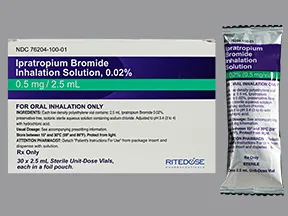 | |
| ipratropium bromide inhalation - | 0.02 % solution |  | |
| ipratropium bromide inhalation - | 0.02 % solution |  | |
| ipratropium bromide inhalation - | 0.02 % solution | 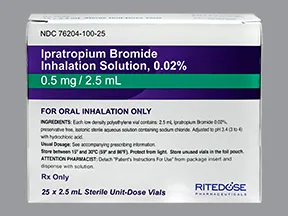 | |
| ipratropium bromide inhalation - | 0.02 % solution |  | |
| ipratropium bromide inhalation - | 0.02 % solution |  | |
| ipratropium bromide inhalation - | 0.02 % solution |  | |
| ipratropium bromide inhalation - | 0.02 % solution | 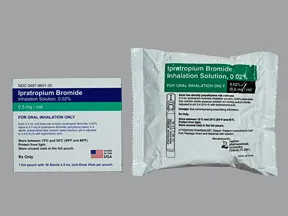 | |
| ipratropium bromide inhalation - | 0.02 % solution | 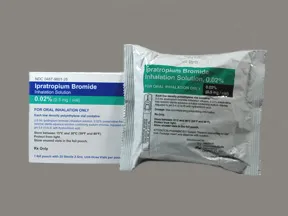 | |
| ipratropium bromide inhalation - | 0.02 % solution | 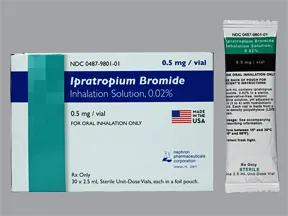 | |
| ipratropium bromide inhalation - | 0.02 % solution | 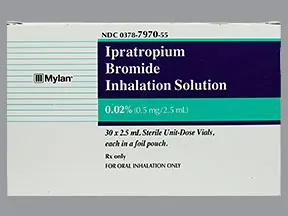 | |
| ipratropium bromide inhalation - | 0.02 % solution |  | |
| ipratropium bromide inhalation - | 0.02 % solution | 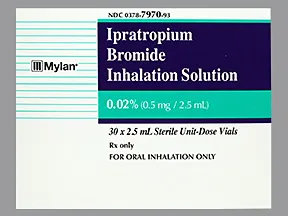 | |
| ipratropium bromide inhalation - | 0.02 % solution |  | |
| ipratropium bromide inhalation - | 0.02 % solution | 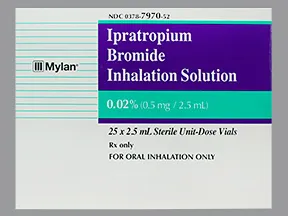 | |
| ipratropium bromide inhalation - | 0.02 % solution |  | |
| ipratropium bromide inhalation - | 0.02 % solution | 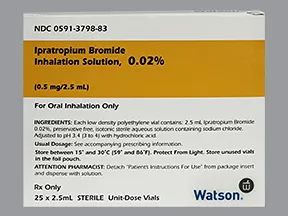 | |
| ipratropium bromide inhalation - | 0.02 % solution | 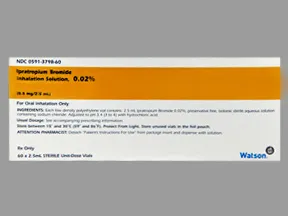 | |
| ipratropium bromide inhalation - | 0.02 % solution | 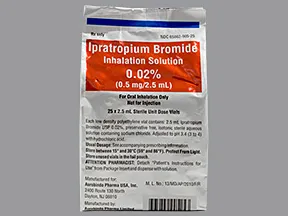 | |
| ipratropium bromide inhalation - | 0.02 % solution | 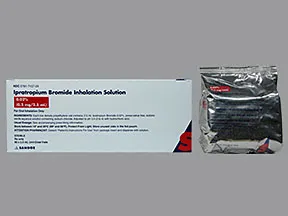 | |
| Ipratropium inhaled (Atrovent) - | 17 mcg/actuation aerosol | 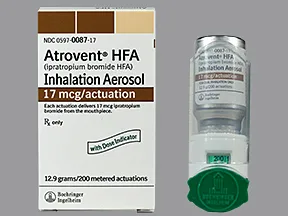 | |
| Ipratropium nasal - | 42 mcg (0.06 %) aerosol |  | |
| Ipratropium nasal - | 21 mcg (0.03 %) aerosol |  | |
| Ipratropium nasal - | 21 mcg (0.03 %) aerosol | 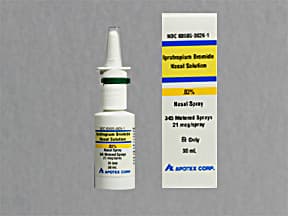 | |
| Ipratropium nasal - | 42 mcg (0.06 %) aerosol | 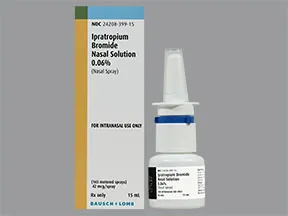 | |
| Ipratropium nasal - | 42 mcg (0.06 %) aerosol |  | |
| Ipratropium nasal - | 21 mcg (0.03 %) aerosol |  | |
| Ipratropium nasal - | 42 mcg (0.06 %) aerosol | 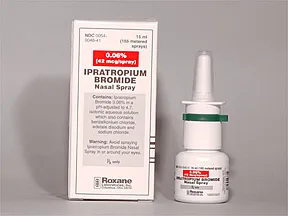 | |
| Ipratropium nasal - | 21 mcg (0.03 %) aerosol | 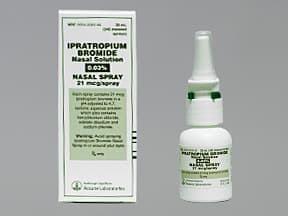 |
Copyright © 2010 First DataBank, Inc.
Patient Handout
ipratropium bromide inhalation
IPRATROPIUM SOLUTION - INHALATION
(IP-ra-TROE-pee-um)
COMMON BRAND NAME(S): Atrovent
USES: Ipratropium is used to control and prevent symptoms (wheezing and shortness of breath) caused by ongoing lung disease (chronic obstructive pulmonary disease-COPD which includes bronchitis and emphysema). It works by relaxing the muscles around the airways so that they open up and you can breathe more easily. Controlling symptoms of breathing problems can decrease time lost from work or school.For preventing symptoms of lung disease, this medication must be used regularly to be effective. Use your quick-relief inhaler or nebulized solution (such as albuterol, also called salbutamol in some countries) for wheezing or sudden shortness of breath unless otherwise directed by your doctor. Ipratropium does not work as fast as your quick-relief medication, but may sometimes be used together with your quick-relief medication to relieve symptoms of wheezing or sudden shortness of breath if so prescribed by your doctor.
HOW TO USE: Read the Patient Information Leaflet if available from your pharmacist before you start using ipratropium and each time you get a refill. This medication is used with a special machine called a nebulizer that changes the solution to a fine mist that you inhale. Learn how to prepare the solution and use the nebulizer properly. If a child is using this medication, a parent or other responsible adult should supervise the child. If you have any questions, ask your doctor, pharmacist, or respiratory therapist.This product should be clear and colorless. Before using, check this product visually for particles or discoloration. If either is present, do not use the liquid.Inhale this medication into your lungs using the nebulizer as directed by your doctor, usually 3 to 4 times a day (6 to 8 hours apart). Avoid getting this medication into your eyes. It may cause eye pain/irritation, temporary blurred vision, and other vision changes. It is recommended that you use a mouthpiece rather than a face mask with the nebulizer or that you close your eyes during use. Each treatment usually takes about 5 to 15 minutes. Use this medication only through a nebulizer. Do not swallow or inject the solution. To prevent infections, clean the nebulizer and mouthpiece/face mask according to the manufacturer's directions.Rinse your mouth after treatment to prevent dry mouth and throat irritation.Ipratropium may be mixed with other medications (such as albuterol) or saline if directed by your doctor. Follow your doctor's instructions carefully. Once a vial is opened, throw away any unused solution.Dosage is based on your medical condition and response to treatment.If you are directed to use this medication regularly, it works best if used at evenly spaced intervals. To help you remember, use it at the same times each day. Do not increase your dose, use this medication more often, or stop using it without first consulting your doctor.Tell your doctor if your symptoms do not improve or if they worsen.Learn which of your inhalers/medications you should use every day and which you should use if your breathing suddenly worsens (quick-relief drugs). Ask your doctor ahead of time what you should do if you have new or worsening cough or shortness of breath, wheezing, increased sputum, waking up at night with trouble breathing, if you use your quick-relief inhaler more often, or if your quick-relief inhaler does not seem to be working well. Learn when you can treat sudden breathing problems by yourself and when you must get medical help right away.
SIDE EFFECTS: See also How to Use section.Dizziness, nausea, stomach upset, dry mouth, or constipation may occur. If any of these effects last or get worse, tell your doctor or pharmacist promptly.Remember that this medication has been prescribed because your doctor has judged that the benefit to you is greater than the risk of side effects. Many people using this medication do not have serious side effects.Rarely, this medication may cause severe sudden worsening of breathing problems right after use. If you have sudden worsening of breathing, use your quick-relief medication and get medical help right away.Tell your doctor right away if you have any serious side effects, including: fast/pounding heartbeat, difficult/painful urination.Get medical help right away if you have any very serious side effects, including: eye pain/swelling/redness, vision changes (such as seeing rainbows around lights at night, blurred vision).A very serious allergic reaction to this product is rare. However, get medical help right away if you notice any symptoms of a serious allergic reaction, including: rash, itching/swelling (especially of the face/tongue/throat), severe dizziness, trouble breathing.This is not a complete list of possible side effects. If you notice other effects not listed above, contact your doctor or pharmacist.In the US -Call your doctor for medical advice about side effects. You may report side effects to FDA at 1-800-FDA-1088 or at www.fda.gov/medwatch.In Canada - Call your doctor for medical advice about side effects. You may report side effects to Health Canada at 1-866-234-2345.
PRECAUTIONS: Before using ipratropium, tell your doctor or pharmacist if you are allergic to it or to tiotropium; or to atropine or other belladonna-type drugs; or if you have any other allergies. This product may contain inactive ingredients, which can cause allergic reactions or other problems. Talk to your pharmacist for more details.Before using this medication, tell your doctor or pharmacist your medical history, especially of: personal or family history of glaucoma (angle-closure type), difficulty urinating (for example, due to enlarged prostate).This drug may make you dizzy or blur your vision or cause vision changes. Alcohol or marijuana (cannabis) can make you more dizzy. Do not drive, use machinery, or do anything that needs alertness or clear vision until you can do it safely. Limit alcoholic beverages. Talk to your doctor if you are using marijuana (cannabis).Before having surgery, tell your doctor or dentist about all the products you use (including prescription drugs, nonprescription drugs, and herbal products).Older adults may be more sensitive to the side effects of this drug, especially problems urinating or constipation.During pregnancy, this medication should be used only when clearly needed. Discuss the risks and benefits with your doctor.It is unknown if this medication passes into breast milk. Consult your doctor before breastfeeding.
DRUG INTERACTIONS: Drug interactions may change how your medications work or increase your risk for serious side effects. This document does not contain all possible drug interactions. Keep a list of all the products you use (including prescription/nonprescription drugs and herbal products) and share it with your doctor and pharmacist. Do not start, stop, or change the dosage of any medicines without your doctor's approval.
OVERDOSE: If someone has overdosed and has serious symptoms such as passing out or trouble breathing, call 911. Otherwise, call a poison control center right away. US residents can call their local poison control center at 1-800-222-1222. Canada residents can call a provincial poison control center.
NOTES: Do not share this medication with others.
MISSED DOSE: If you miss a dose, use it as soon as you remember. If it is near the time of the next dose, skip the missed dose. Use your next dose at the regular time. Do not double the dose to catch up.
STORAGE: Store at room temperature away from light and moisture. Do not store in the bathroom. Keep all medications away from children and pets.Do not flush medications down the toilet or pour them into a drain unless instructed to do so. Properly discard this product when it is expired or no longer needed. Consult your pharmacist or local waste disposal company.
MEDICAL ALERT: Your condition can cause complications in a medical emergency. For information about enrolling in MedicAlert, call 1-888-633-4298 (US) or 1-800-668-1507 (Canada).
Information last revised March 2024. Copyright(c) 2024 First Databank, Inc.
IMPORTANT: HOW TO USE THIS INFORMATION: This is a summary and does NOT have all possible information about this product. This information does not assure that this product is safe, effective, or appropriate for you. This information is not individual medical advice and does not substitute for the advice of your health care professional. Always ask your health care professional for complete information about this product and your specific health needs.
Formulary
Adding plans allows you to compare formulary status to other drugs in the same class.
To view formulary information first create a list of plans. Your list will be saved and can be edited at any time.
Adding plans allows you to:
- View the formulary and any restrictions for each plan.
- Manage and view all your plans together – even plans in different states.
- Compare formulary status to other drugs in the same class.
- Access your plan list on any device – mobile or desktop.





